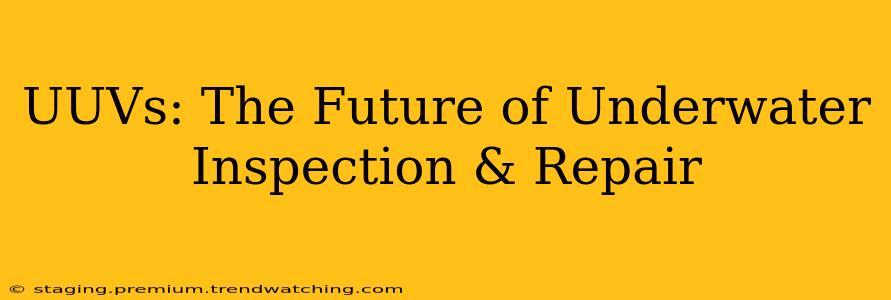Unmanned underwater vehicles (UUVs), also known as autonomous underwater vehicles (AUVs) or remotely operated vehicles (ROVs), are revolutionizing underwater inspection and repair. These submersible robots offer significant advantages over traditional methods, leading to increased efficiency, safety, and cost-effectiveness in various industries. From offshore oil and gas to aquaculture and marine research, UUVs are rapidly becoming indispensable tools. This article delves into the capabilities and benefits of UUVs, addressing common questions surrounding their application and future potential.
What are the different types of UUVs used for underwater inspection and repair?
There are primarily two types of UUVs used for underwater inspection and repair: Remotely Operated Vehicles (ROVs) and Autonomous Underwater Vehicles (AUVs). ROVs are tethered to a surface vessel, allowing for real-time control and data transmission. This makes them ideal for complex tasks requiring human intervention. AUVs, on the other hand, operate independently, pre-programmed with missions and capable of navigating autonomously. Their endurance and ability to access remote or hazardous locations make them perfect for extensive survey work. Within these categories, there's further specialization based on size, payload capacity, and sensor technology, allowing for tailored solutions for specific applications. For example, smaller, more maneuverable ROVs might be used for detailed inspections in confined spaces, while larger AUVs could be deployed for wide-area surveys.
What are the advantages of using UUVs for underwater inspection and repair compared to traditional methods?
Traditional underwater inspection and repair methods often rely on human divers, which can be dangerous, expensive, and time-consuming. UUVs offer several key advantages:
- Enhanced Safety: Eliminating the need for human divers significantly reduces risks associated with underwater operations, such as decompression sickness, equipment failure, and unpredictable marine environments.
- Increased Efficiency: UUVs can operate continuously for extended periods, covering larger areas and completing tasks much faster than human divers.
- Cost Savings: While the initial investment in UUV technology can be significant, the long-term cost savings associated with reduced labor costs, improved safety, and minimized downtime often outweigh the initial expense.
- Improved Accessibility: UUVs can access difficult-to-reach locations and operate in harsh environments unsuitable for human divers, such as deep-sea environments or areas with strong currents.
- Data Acquisition: UUVs are equipped with a variety of sensors (cameras, sonar, etc.) that provide high-quality data for detailed analysis and reporting.
How much does it cost to use UUVs for underwater inspection and repair?
The cost of deploying UUVs varies considerably depending on several factors, including the type of UUV, the complexity of the mission, the duration of the deployment, and the required level of support. Smaller, simpler ROVs may cost less to operate, while larger, more sophisticated AUVs with advanced sensor packages will be significantly more expensive. Rental options exist, allowing companies to access the technology without substantial capital investment. However, thorough cost-benefit analysis considering labor, safety, and downtime should always be performed.
What are the limitations of using UUVs for underwater inspection and repair?
Despite the numerous advantages, UUV technology also has limitations:
- Technological Complexity: Operating and maintaining UUVs requires specialized skills and expertise.
- Environmental Factors: Weather conditions, water clarity, and strong currents can impact UUV operations.
- Communication Challenges: Maintaining reliable communication with AUVs, especially in deep-sea environments, can be challenging.
- Payload Capacity: The payload capacity of UUVs can limit the size and weight of tools and equipment that can be deployed.
- Initial Investment: The initial cost of purchasing or leasing UUVs can be substantial.
What is the future of UUVs in underwater inspection and repair?
The future of UUVs in underwater inspection and repair is bright. Ongoing technological advancements are leading to the development of more robust, intelligent, and capable systems. We can expect:
- Increased Autonomy: AUVs will become increasingly autonomous, capable of performing complex tasks without human intervention.
- Improved Sensors: Advances in sensor technology will provide higher-resolution data and enable more precise inspections.
- Enhanced Manipulation Capabilities: UUVs will be equipped with more sophisticated robotic arms and manipulators for more precise repair tasks.
- Greater Endurance: Improved battery technology and energy-efficient designs will extend the operational time of UUVs.
- Wider Adoption: As the technology matures and costs decrease, the adoption of UUVs across various industries will continue to grow.
The integration of artificial intelligence (AI) and machine learning (ML) will further enhance UUV capabilities, enabling automated anomaly detection, improved navigation, and more efficient data analysis. This will lead to more cost-effective and safer underwater operations, propelling UUVs to the forefront of underwater inspection and repair for years to come.

